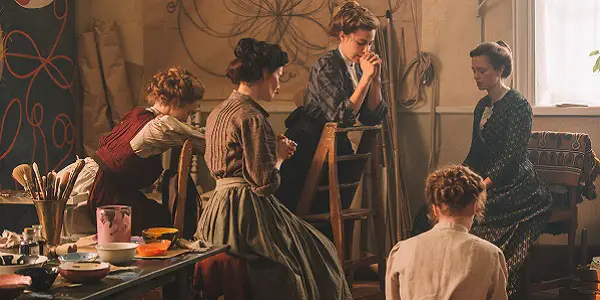HILMA: An Ordinary Film About An Extraordinary Woman

Lee Jutton has directed short films starring a killer toaster,…
Like so many other groundbreaking women, the artist and mystic Hilma af Klint was not properly appreciated during her lifetime. Trained at Sweden’s Royal Academy of Fine Arts, the incredibly talented af Klint made a living through portraits, landscapes, and botanical drawings. But her true life’s work was a series of abstract paintings — culminating in her landmark cycle, The Paintings for the Temple — that she claimed were dictated to her by spiritual forces. Her art strove to make the invisible visible and was heavily influenced by science and technology as well as her spiritual practice. Yet it wasn’t until long after her death in 1944 that af Klint took her much-deserved place alongside that of her male contemporaries in the history of abstract art.
Interest in af Klint’s intriguing life and work has skyrocketed in recent years, manifesting in an insanely popular retrospective at New York’s Guggenheim in 2018, a feature-length documentary from director Halina Dyrschka in 2019, and now, her own biopic. Directed by Lasse Hallström (My Life as a Dog, Chocolat), Hilma stars his wife, the acclaimed actress Lena Olin, as the older af Klint and their daughter, Tora Hallström, as the artist as a young woman. Yet despite — or perhaps because of — the prestige of those involved in the project, Hilma is far too ordinary a film to do justice to such an extraordinary subject.
What Lies Beyond
As a young woman, the tragic death of her beloved younger sister made af Klint keenly interested in the spiritual world: the world beyond what we can see, the world beyond the living. When af Klint enters the Royal Academy of Fine Arts at the age of 20, she meets a fellow student, Anna Cassel (Catherine Chalk) who shares her interest in these unseen forces. Together with three other women, they form a group called The Five, who regularly hold seances to receive messages from spirit guides known as the High Masters.

During this time, af Klint begins experimenting with automatic drawing, allowing the spirits to guide her hand, creating abstract works that use line, shape, and color in new and exciting ways. Yet her work is dismissed by many who do not understand it, including her hero, the philosopher Rudolf Steiner (Tom Wlaschiha), whose criticism of her work nearly causes her to give up on painting entirely.
When af Klint ends up submitting more conventional pieces of hers for a gallery show, only to wander into a crowd admiring new abstract pieces by a male artist called Kandinsky, she collapses with disappointment and frustration. Why can Kandinsky show this work and receive acclaim, while her own work is dismissed as the eccentric scribblings of a witch? This scene and that of Steiner’s rejection encapsulate how the patriarchy worked to suppress af Klint’s work during her lifetime; it’s no wonder that, on her deathbed, she urges her nephew to box up her work and not unveil it to the public until twenty years after she’s gone.
Seeing the Invisible
Hilma af Klint is now rightfully recognized as a pioneering abstract artist. Yet Hilma focuses less on the potent mix of philosophy, science, and religion that guided her work and more on her relationship with Cassel — an important one in both women’s lives, which lasted until Cassel’s death in 1937. While af Klint was descended from a family of naval officers that had nobility bestowed upon them but no fortune to match, Cassel came from a nouveau riche merchant family and was able to finance af Klint’s work when no one else would. This, naturally, led to friction between the two women, especially since Cassel’s own art tended to be much more conventional (and less compelling) than af Klint’s commissions from the spiritual realm. Jealousy also flares up when af Klint begins spending a great deal of time with her mother’s nurse, Thomasine (Jazzy De Lisser).

It remains refreshing to watch a historical film in which almost all of the major characters are women; the few men who do appear on screen are generally representatives of the villainous patriarchy, such as Steiner and af Klint’s brother, who refuses to see her when she comes to him asking for funding for the Temple. As the young af Klint, Tora Hallström has an engaging, lively screen presence; her almost androgynous beauty is an ideal fit for portraying such an unconventional woman, someone who in one scene describes herself as the masculine to Cassel’s feminine. And as the artist towards the end of her life, the always-excellent Lena Olin conveys desperation mixed with dignity, the desire to have her work appreciated the way it is meant to be combined with the knowledge that the world is not ready to do so.
Yet Hilma is inevitably a letdown, for who could possibly shoehorn such an unusual woman’s life into such an overused format as the two-hour prestige biopic and expect to succeed? Af Klint’s life should be rendered as vibrant and exciting as her art, and while Hilma is gorgeously crafted, it leaves one wanting more. Hallström’s screenplay and direction are as competent and respectful as one would expect, but a filmmaker who would be a match for af Klint in artistic approach—someone willing to take risks and experiment visually, instead of playing it safe — would have been a far more suitable choice to tell af Klint’s story.

The focus on af Klint’s romantic life at the expense of her spiritual one is just one aspect of this approach; perhaps af Klint’s relationship with Cassel is easier to understand than her relationship with the spirits, but the latter is so much more fascinating, and so much more important to appreciate her art. Nonetheless, Hilma does include a few interesting visual sequences showcasing af Klint’s creative process and a lovely coda in which the artist is able to witness her work being showcased at the Guggenheim — a show that was appropriately titled Hilma af Klint: Paintings for the Future.
Conclusion
Hilma af Klint broke every mold during her life, yet in honoring her legacy, Hilma attempts to jam her into a new one. You’re much better off seeking out the next showing of her art near you.
What do you think? Are you familiar with the work of Hilma af Klint? Share your thoughts in the comments below.
Hilma opens in theaters in the UK on October 28, 2022. You can find more international release dates here.
Watch Hilma
Does content like this matter to you?
Become a Member and support film journalism. Unlock access to all of Film Inquiry`s great articles. Join a community of like-minded readers who are passionate about cinema - get access to our private members Network, give back to independent filmmakers, and more.
Lee Jutton has directed short films starring a killer toaster, a killer Christmas tree, and a not-killer leopard. Her writing has appeared in publications such as Film School Rejects, Bitch: A Feminist Response to Pop Culture, Bitch Flicks, TV Fanatic, and Just Press Play. When not watching, making, or writing about films, she can usually be found on Twitter obsessing over soccer, BTS, and her cat.












